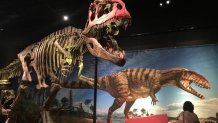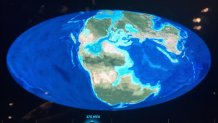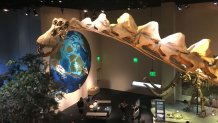What to Know
- Ultimate Dinosaurs is on display through January 6, 2019.
- Attractions include 15 fully articulated dinosaur casts, more than a dozen prehistoric specimens, augmented reality and more.
- The Perot Museum of Nature and Science is located at 2201 N Field Street in Dallas.
From pet-sized creatures to intimidating giants, the world of dinosaurs is now on display at Ultimate Dinosaurs at the Perot Museum of Nature and Science in Dallas through January 6.
The exhibition features 17 dinosaurs unfamiliar to most North Americans, including scientists. “I think this exhibition is spectacular because even as a professional paleontologist, this is my first time seeing some of these skeletons,” Dr. Tony Fiorillo, Perot Museum’s Chief Curator and Vice President of Research and Collections, said.

Dr. Ron Tykoski, Perot Museum’s Director of the Paleontology Lab says the exhibit features animals from the Southern hemisphere, many that will be new to visitors. These southern hemisphere specimens include Giganotosaurus, a larger relative of Tyrannosaurus Rex, that roamed around what is now Argentina, and Eoraptor, a petit dinosaur believed to have weighed about 22 lbs.
No matter the size, these southern hemisphere dinosaurs continue the fascination with the pre-historic creatures. “At some level, it’s almost this primal thing in humans. If you think about kids, almost every kid has nightmares and it’s some big toothy thing chasing the kid in its sleep. I think there’s something about dinosaurs that speaks to that because they’re big, many of them have sharp teeth, but they are also conveniently dead. It allows people to address their nightmare but within a safety zone,” Fiorillo said.
“Some of them just look weird,” Tykoski added. “You just look at them and go, ‘Oh come on, how could that have actually existed?’ They’ve been gone so long you really have to fire up your imagination to put skin and flesh on these animals.” Dinosaurs lived 250 million years ago, dying out about 65 million years ago.

Among the skeletons, life-size video projections, interactive games and augmented reality viewers, a display shows how the supercontinent Pangaea broke apart into modern-day continents, forcing dinosaurs to adapt.
Local
The latest news from around North Texas.
“Dinosaurs were an incredibly successful group,” Fiorillo said. “Dinosaurs tell us something not only about diversity, but how resilient life can be. Dinosaurs lived on all of the continents and there are lessons to learn about what that means for the modern world.”
Tykoski points out similar attributes and key differences between dinosaurs on display, illustrating the relationships between the species on different continents.
“This exhibit here highlights how groups of dinosaurs evolved very differently on continents that had separated out and floated around like rafts, not touching anyone else and in complete isolation for years,” Tykoski said. “This is a showcase of how evolution occurs.”
In addition to learning about how dinosaurs adapted to different climates on different continents, paleontologists learned about a surprising attribute a couple of decades ago: some dinosaurs had feathers.
“I was actually at the professional meeting where that announcement was made. It was in New York in 1996,” Tykoski said. “Lo and behold, a paleontologist got up there with a slideshow and said, ‘I’m here to show you some discoveries we got in China.’ And he flashed up a slide and there is what was obviously a meat-eating dinosaur, a small one, with feathers preserved in the rock surrounding the body.”
Tykoski recalls the collective gasp as everyone recognized this discovery as a paradigm shift. Paleontologists note the carbon film from the feathers creating an inky outline in the rock and there is a scientific consensus that birds are a group of theropod dinosaurs. Artwork in this exhibition depicts several dinosaurs with feathers, signifying this discovery.

After viewing the 15 fully articulated dinosaur casts, touching fossilized dinosaur specimens and playing with miniature dinosaur dioramas in Ultimate Dinosaurs, visitors of all ages are encouraged to ride the glass-enclosed escalator, newly renamed the 'T. Rexcalator,' to the fourth floor. At the top of escalator, a life-sized cast of 'Stan,' the second most complete T. Rex skeleton ever found, looms overhead, greeting visitors as they explore even more dinosaurs in the T. Boone Pickens Life Then and Now Hall. In addition to dancing with a virtual dinosaur avatar, visitors can learn how paleontologists use prehistoric footprints to study dinosaur anatomy and behavior. Learning how dinosaurs lived and moved only adds to the endless curiosity. “They press the limits of our imagination,” Tykoski said.
MORE: PerotMuseum.org



